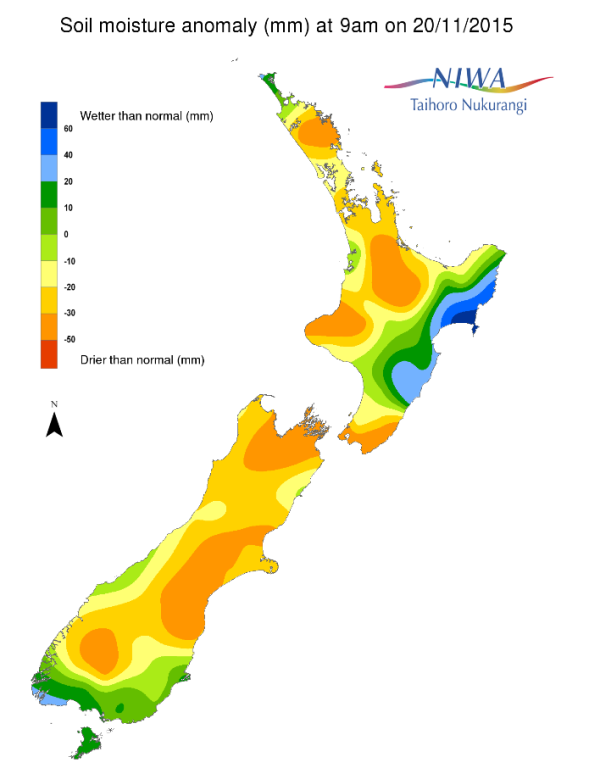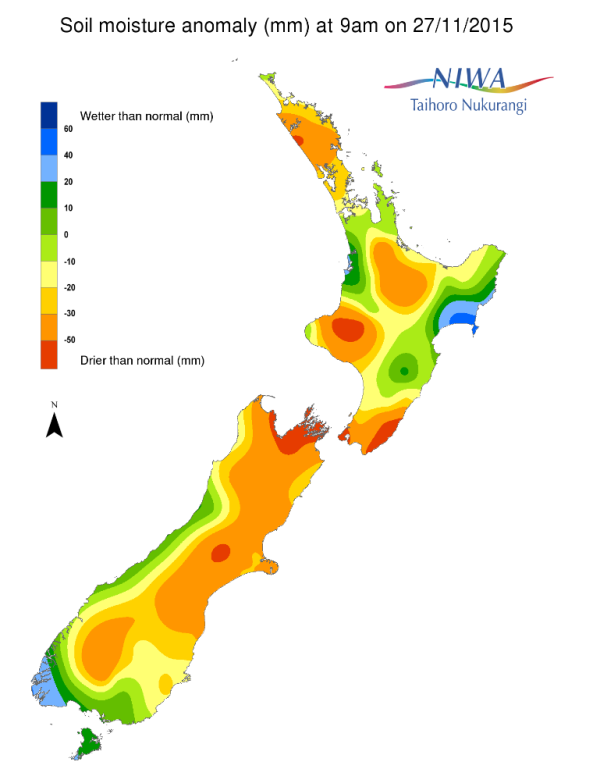Hotspot watch is a weekly update describing soil moisture across the country to help assess whether severely to extremely dry conditions are occurring or imminent.
Regions experiencing these soil moisture deficits are deemed “hotspots”. Persistent hotspot regions have the potential to develop into drought.
Soil moisture
For the North Island, soil moisture levels increased in the Auckland and northern Waikato regions largely due to the active weekend storm which impacted these areas. Other parts of the North Island saw soil moisture levels decrease when compared to this time last week. The driest soils can be found in Wairarapa and are considered to be severely drier than normal for the time of year. Wetter than normal soils for this time of year continue to exist in the southern Gisborne and Hawke’s Bay regions.
The past week has seen very little rain fall over the South Island and as result soil moisture levels decreased across the entire island. High temperatures and persistent northwesterly to southwesterly winds throughout the week also contributed to the reduction of soil moisture, particularly in the Nelson, Marlborough and Canterbury regions. Soil moisture levels from eastern Marlborough to far northeastern Canterbury, roughly from Blenheim to Kaikoura, continue to be severely to extremely drier than normal for this time of year. Farther south, and east of the Divide, nearly the whole of eastern Canterbury to northeast Otago is experiencing much drier to severely drier than normal soils for this time of year. Coastal parts of the West Coast and southern Southland are the only areas in the South Island with near normal soil moisture levels for the time of year.
Outlook
For the North Island, showers, some possibly heavy, are expected over the Auckland region during Friday evening with more widespread rain across most of the island throughout Saturday. Beyond, high pressure regains its position over the North Island, bringing with it largely dry weather for the week ahead. As a result, soil moisture levels across the North Island over the next seven days are expected to remain largely unchanged in the Auckland region but likely decrease elsewhere.
For the South Island, a front currently moving up the Island is bringing widespread rain and showers, particularly west of the Divide. Thereafter, the arrival of high pressure on Sunday will see a return to dry conditions. As the high moves eastwards mid-week, winds will turn northwesterly. Rain associated with this airflow will be contained to the West Coast as the Southern Alps will block much of the moisture from making it east. In the upper and eastern South Island, these northwesterlies are expected to bring another bout of hot and dry conditions and, as a result, soil moisture levels in these areas are expected to drop even further over the next seven days. Conversely, soil moisture levels west of the Divide are expected to increase.
Overall, a hotspot persists and has expanded in the Wairarapa region. In the South Island, hotspots exist in eastern Marlborough and from central Canterbury through to northeast Otago.
Background
Hotspot Watch a weekly advisory service for New Zealand media. It provides soil moisture and precipitation measurements around the country to help assess whether extremely dry conditions are imminent.
Soil moisture deficit
The amount of water needed to bring the soil moisture content back to field capacity, which is the maximum amount of water the soil can hold.
Soil moisture anomaly
The difference between the historical normal soil moisture deficit (or surplus) for a given time of year and actual soil moisture deficits.
Dry and extremely dry soil
Definitions: “Extremely” and “severely” dry soils are based on a combination of the current soil moisture status and the difference from normal soil moisture.
Check out NIWA's soil moisture maps
Soil moisture anomaly maps
Pictured below are soil Moisture Anomaly Maps, relative to this time of year. The maps show soil moisture anomaly for the past two weeks.


